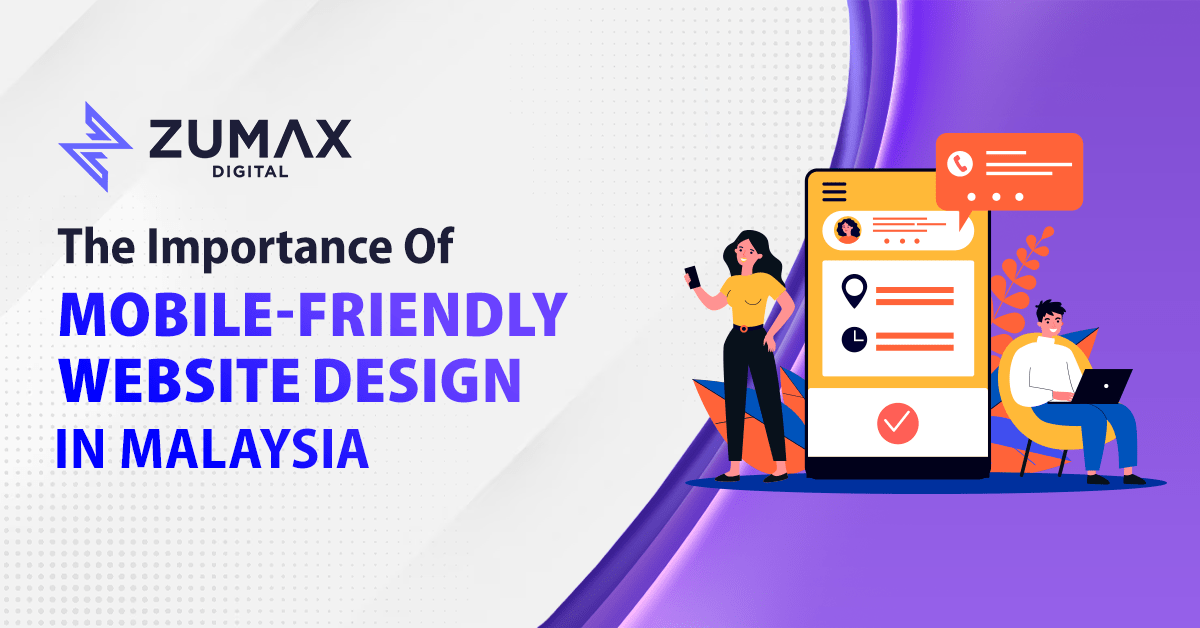
The Importance of Mobile-Friendly Website Design in Malaysia.
Mobile devices are an essential part of our lives today, slowly impacting the way website design is designed. The changes in user behaviour have shifted the website design. In the past, the website was designed specifically to be browsed on a desktop. However, now we usually visit a website using our mobile phones rather than opening up our laptops to browse it. In this blog post, we will talk about the importance of mobile-friendly website design in Malaysia.
Introduction
Mobile devices not only change our way of communicating but also affect our lifestyles, attitudes, and expectations.
Imagine a situation where you want to access a website for information via mobile devices. But all buttons and content are small and difficult to read. Will you go to the next mobile-friendly website or keep browsing?
Mobile devices have made our lives so much easier as compared with the past, which also affected our expectations. We expect everything to be accessible via our mobile phones, and the same goes for the company’s website. In today’s era, it is essential for businesses to have a mobile-friendly website design in Singapore and Malaysia.
What does a Mobile-Friendly Website mean?
A mobile-friendly website is designed to perfectly fit into a variety of screen sizes of smartphones or tablets. This can be achieved by using a responsive design that will adjust the website’s layout to be viewed on any screen size perfectly.
A well-designed mobile-friendly website should have the following key features:
- Easy to read
- Mobile-friendly navigation
- Visually appealing on all screen sizes
- Fast loading speed and performance.
Why Mobile-Friendliness Website Design is Important?
Based on an analysis of Statista, mobile phone users in Asia have accounted for approximately 68.8% of web traffic. This indicates that the majority of users access websites via their mobile phones. Not only that, Google has announced that mobile-friendliness has a huge impact on the ranking of search engine results. On account of this, it is essential for businesses in Malaysia to have a mobile-friendly website.
Enhance User Experience.
A mobile-friendly website can enhance users’ experiences because it makes information easily accessible on any device. In contrast, if a website is not mobile-friendly, it will result in a negative user experience because they may find difficulty navigating buttons or content. This will also lead to higher bounce rates because users will switch to the next website.
Enhanced Search Visibility and Search Engine Optimization (SEO)
Google stated that a mobile-friendly website design will rank higher in the search results, this indicates that a mobile-friendly website has a huge impact on Search Engine Optimisation (SEO). As a consequence, a mobile-friendly website will get more search exposure and more organic traffic. Conversely, non-mobile-friendly websites might result in lower search exposure because they may not rank highly in Google search results.

If you are interested in our SEO services in Malaysia, contact us, and let’s have a discussion on how to optimise your website today!
Increase Lead Generation
Mobile-friendly websites are essential for increasing lead generation. In today’s fast-paced digital world, customers seek prompt satisfaction where everything is accessible through their mobile phones. A non-mobile-friendly website may result in losing potential leads and sales because users will switch to other websites when they find navigating it cumbersome. On the other hand, a mobile-friendly website allows users to easily access and take action via mobile phones, which may result in higher leads and lower bounce rates.
Best Practices for Mobile-Friendly Website Design
Designing a mobile-friendly website can be challenging, but here are some best practices that can assist you in creating a mobile-friendly website that offers a positive users’ experience. Here’s some essential tips to keep in mind:
Optimize Your Website for Thumb-Friendly Mobile Navigation
Ensure your websites can be easily browsed for mobile users because it’s very easy for users to accidentally tap on the incorrect button or link on smaller screens. Hence, it’s important to design a mobile-friendly website with thumb-friendly buttons and links to enhance a positive user experience.
Tip: Avoid placing important links or buttons close to the screen’s edges because this may be challenging for users to tap precisely.
Use Mobile-Friendly Fonts
When developing a mobile-friendly website, it is crucial to use easily readable fonts and optimise the font size to make it mobile-friendly. This will ensure a positive user experience, as visitors will be able to read information easily even with a smaller screen.
Use Responsive Design
Using a responsive web design allows your website design layout to adapt to any screen size. This may provide a positive user experience because they can explore with ease on any device. Additionally, Google will prioritise mobile-friendly websites in the search ranking results. Thus, you can increase your website’s exposure and traffic by implementing responsive design.
Tips: Using responsive design could save you time coding buttons or elements to work on different devices. This might save a lot of time and money!
Optimize your images
Mobile page load speeds could be impacted by the image formats that we used for desktop websites. To ensure better performance, compress your images and select a mobile-friendly format. Additionally, to prevent over-optimisation and impact on the final layout, you can test how your images will appear on different screen sizes using a responsive test tool.
Focus on Speed
Both search engine rankings and user experience are directly impacted by a website’s loading speed. Slow loading speed might result in higher bounce rates and lower visitors. Mobile page loading speed may vary from desktop speeds, thus, it’s important to regularly check the performance of your websites, particularly on mobile devices.
Limit Pop-Ups and Ads
Pop-ups and ads can be useful for increasing conversion rates and leads, but they can also frustrate mobile users, particularly when accident taps happen. Overwhelming pop-up ads will impact your search engine ranking and increase bounce rates. Limiting pop-ups and ads is particularly important for mobile-friendly websites to ensure a positive user experience.
Test on Different Devices
Testing websites across a range of devices with different screen sizes and operating systems is the most effective way to understand their mobile friendliness and performance. Additionally, testing should be carried out at every stage of the development progress and on a regular basis following website maintenance.
Tips: Use Google Analytics to learn how visitors interact with your website. You can use these insights to find and remove extra elements that could negatively impact the mobile user experience.
Conclusion
While mobile devices now account for the majority of web traffic, a mobile-friendly website is no longer optional but essential for businesses in Malaysia. Optimising mobile-friendly website design in Malaysia allows businesses to improve user experience, search engine rankings, and higher leads and sales.
A well-designed mobile-friendly website should be practical and easy to use in addition to being visually pleasing. Following the best practices and tips in this blog post, you will be able to create a performing mobile-friendly website.
Need a mobile-friendly Website?
Contact Zumax Digital today. Our web design company in Malaysia has more than 8 years of experience in Malaysia and Singapore website design. We can design a mobile-friendly website that meets your unique requirements while also being visually pleasing.




